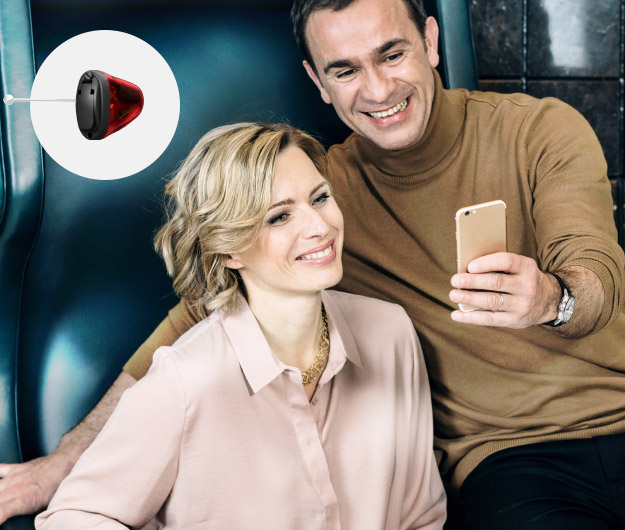
Find the right hearing aid
for you
Prices Types Models and brands Save up to $2,100 Find a hearing clinic Government funding and 0% financing Features Book 30-day FREE trial
Comfortable hearing aids for all age groups, including seniors looking for reliable, easy-to-use solutions.
Quality hearing aid solutions at HearingLife
If you are experiencing difficulty hearing, it could be due to issues with your outer ear, such as a blockage in the ear canal or damage to the ear drum. At HearingLife, we offer a variety of hearing aids that can help improve sound amplification and clarity for those with outer ear problems where no medical treatment is possible. Our selection includes trusted brands like Oticon, Phonak, Bernafon, Phillips, Widex, Starkey, and Signia—names known for comfort, technology, and performance.
Background noise can be a major challenge for people with hearing loss. That's why our hearing aids are equipped with advanced noise reduction features that can help filter out unwanted background noise and improve speech recognition. Whether you're in a busy restaurant, on a crowded street, or at a lively event, our hearing aids can help you hear more clearly in challenging environments.
With our 90-day, risk-free trial period, you can experience life with them at home before you commit!
Book a FREE hearing aid trial Request a callback to learn more
What is a hearing aid?
They are small, high-tech devices that help you hear if you suffer from hearing loss. They intelligently amplify your surrounding sounds (such as conversations, TV shows, or the radio) to help you communicate and participate in everyday situations.
“When paired with comprehensive hearing care, today’s advanced hearing aids are typically small and discreet, while being able to improve auditory experiences and restore meaningful connections,”
Katie Koebel, Audiologist, M.Cl.Sc., Reg. CASLPO
How does a hearing aid work?
Sound is carried across three different parts:
- Microphone - receives sound waves and converts them into electrical signals
- Amplifier - increases the strength of the audio signals and sends them on to the ear
- Receiver / speaker - converts the amplified electrical audio signals into sound and sends them further into the ear canal

4 popular types of hearing aids
How new hearing aids are transforming lives with technology
Hearing loss can feel isolating, muffling the conversations, music, and laughter that enrich our lives. But what if a tiny piece of technology could not only restore sound, but tailored to blend smoothly into your lifestyle and unique needs? That's the reality of new hearing aids, and they're revolutionizing the way we approach hearing health. One of the most recent being Oticon Intent - the world’s first hearing aid with user intent technology.
These new hearing aids may be small, but their impact is huge! Contrary to the myth that hearing aids are bulky, today's models are discreet yet life-changing, offering personalized solutions that perfectly align with your unique hearing care needs, lifestyle, and budget. Here are a few of the many ways these new hearing aids can improve your lifestyle with the technological advancements that come with them:
Effortless connectivity: stream directly from your devices
Why settle for muffled phone calls or frustrating Bluetooth connections? New hearing aids seamlessly connect with your smartphone or other devices, allowing you to stream music, calls, and audio directly to your ears.
Smartphones become hearing aid control centers
Many new hearing aids connect with user-friendly smartphone apps. This puts the power of customization at your fingertips, allowing you to discreetly adjust settings and personalize your hearing experience in real-time.
Rechargeable convenience: say goodbye to dead batteries
No more scrambling for batteries! Many new hearing aids come with built-in rechargeable batteries, offering long-lasting power and eliminating the need for constant replacements.
Why choose hearing aids that come with personalized support?
Hearing aids often purchased without thorough assessments are like taking medication without a prescription. It might offer some relief, but without proper guidance, it could lead to ineffective results or even complications. They might amplify sound, but they won’t provide the clarity and comfort you need for everyday activities.
Our commitment to your hearing health doesn’t stop once you’ve purchased your hearing aids. We provide personalized guidance even after your purchase.
Hearing aid types comparison table
There’s more than one factor to consider when choosing a hearing device. To make sure you get the one that’s right for you, you’ll need to consider a few things, such as the severity of your hearing loss, ear canal shape, dexterity, lifestyle, your budget and other personal preferences. The guide below will help you get to grips with the differences between the main types of hearing aids.
Behind-the-ear Plus/Ultra Power |
In-the-canal |
miniRITE (Receiver-in-the-ear) |
miniRITE R (Receiver-in-the-ear) |
||||
| Most discreet | ✔ | ✔ | - | - | ✔ | ✔ | ✔ |
| Bluetooth connectivity | ✔ | - | ✔ | ✔ | ✔ | ✔ | - |
| Long battery life | ✔ | - | - | ✔ | ✔ | ✔ | - |
| Easy to adjust volume and programs | ✔ | - | - | ✔ | ✔ | ✔ | - |
| Exchangeable battery | ✔ | ✔ | ✔ | ✔ | ✔ | - | ✔ |
| Rechargeable battery | ✔ | - | - | - | - | ✔ | - |
| Mild to moderate hearing loss | ✔ | ✔ | ✔ | ✔ | ✔ | ✔ | ✔ |
| Severe hearing loss | ✔ | - | - | ✔ | ✔ | ✔ | - |
| Profound hearing loss | ✔ | - | - | - | - | - | - |
Seeing a hearing care professional vs online or over-the-counter hearing aids
When it comes to hearing health, expert care makes all the difference. Hearing care professionals offer personalized support, proper testing, and technology that’s tailored to your needs—unlike generic devices you’ll find online or over the counter. That’s why it’s important to understand the difference between seeing a hearing care professional and buying hearing aids online or over the counter in Canada.
Hearing amplifiers vs. hearing aids: What's the difference?
Though they may look similar, hearing amplifiers and hearing aids serve very different purposes. Amplifiers simply make all sounds louder, while hearing aids are finely tuned to your specific hearing loss, improving clarity and comfort. If you’re unsure which one is right for you, learn more about the key differences between hearing amplifiers and hearing aids.

Book a free, 30-day hearing aid trial
We have a wide range of models available with cutting-edge technology.
Try hearing aids at home for 30 days - no obligations.
Book a FREE consultation Request a call back
6 benefits of wearing hearing aids
Bob
"When I play softball, it's not only about winning, it's also about communicating with my teammates. The social aspects. And not missing out on anything in my life"
|
Audio |
Visual |
|
Music I would say the most important thing in life is the freedom to be yourself.
|
Bob is smiling while getting ready to play softball |
|
Music
I have an ambitious mindset. I want to perform when it comes to sports. I want to perform when it comes to work.
And actually, I want to live my life to the fullest.
|
Bob holds a softball bat and warms up.
Bob walks towards his teammate and gives him a fist bump |
|
Music
Imagine that ability being taken away from you.
|
Bob sits on the spectator row and watches the others play while talking with his teammate |
|
Music
I am taking the responsibility to be free. Free to achieve things in life with no compromise.
|
Zoom in on Bobs face. Zoom out on Bob throwing the ball.
Bob talks with an audiologist in a clinic |
|
Music
When I play softball, it is not only about winning. It is also about communicating with my teammates. The social aspect and not missing out on anything in my life.
|
Bob inserts his hearing aids and interacts with his teammates |
|
Music |
White screen: Audika Logo |
Hearing aid brands and models
There are many high-quality, reliable hearing devices on the market. Each brand or model is unique in its own way, and it can be difficult knowing where to start. We’ve brought together the most important information about the brands and models we offer at HearingLife. This way, you can get a quick overview of all your different available options.
Latest hearing aid technologies and features
Hearing aids have gone through major technological innovations during the past decade marked by new advances in hearing aids. Today's digital hearing devices deliver better sound quality and can make your life easier through intelligent, high-tech features.
How can I adjust to my new hearing aids?
Getting used to your hearing aids is a unique and personal experience that requires patience and a positive mindset. Here are some friendly tips to guide you through this exciting journey:
- Gradual Improvement:
- Understand that your hearing aid won't restore normal hearing but will enhance it by amplifying soft sounds.
- Embrace the gradual improvement in your listening skills as you adapt to the sounds around you.
- Allow Time for Adjustment:
- Getting used to your new hearing aid takes time, and that's perfectly normal. Be patient with yourself.
- The more consistently you use your hearing aid, the quicker you'll adjust to the amplified sounds.
- Variety is the Spice of Hearing:
- Practice using your hearing aid in different environments to familiarize yourself with how amplified sounds may vary.
- Whether it's a busy street or a quiet room, each setting offers a unique auditory experience.
- Support is Key:
- Seek support from family and friends, whose encouragement can make a significant difference.
- Consider joining a support group for individuals with hearing loss or those new to hearing aids.
Artificial Intelligence in hearing aids
AI-powered hearing aids work like a personal assistant for your ears. With built-in artificial intelligence, these advanced devices learn what sounds are most important to you—helping you hear them more clearly and comfortably throughout the day.
The latest breakthrough in hearing technology, AI hearing aids can:
- Automatically adapt to your environment in real time
- Sharpen speech clarity, even in noisy settings
- Minimize background noise and sudden disruptions
- Learn your listening preferences for a truly personalized experience

What is the best hearing aid on the market?
Hearing aids are not one-size-fits-all solutions and online reviews can be subjective. We want to help you find the best hearing aid, one that’s tailored to you including considerations for new advances in hearing aids. To do this, we’ll help you carefully consider the following:
- Your hearing ability
- Type & technology
- Comfort
- Price and quality
- Your lifestyle and listening situations
- Your dexterity / vision and other individual needs
By carefully considering these factors and staying informed about new advances in hearing aids, you can confidently choose the perfect hearing aid that suits you best.
Hearing Aid Prices in Canada
Hearing aid prices in Canada vary depending on the level of technology, features, and your unique hearing needs. From standard models to advanced options, there’s a range of solutions to match different lifestyles and budgets. To explore what’s available and what to expect, learn more about hearing aid prices in Canada.
Finance & payment plans | HearingLife Canada
You don’t need a referral from a doctor to receive a free consultation or to purchase a hearing device at one of our clinics.
We are happy to help you understand the different payment plans and funding options that are available to you.



















